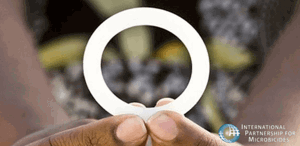Kat KelleyGHTC
Kat Kelly is a senior program assistant at GHTC who supports GHTC's communications and member engagement activities.

GHTC member the International Partnership for Microbicides (IPM) announced last week the results of two phase 3 clinical trials demonstrating that a monthly vaginal ring filled with the antiretroviral drug dapivirine can reduce the risk of HIV infection in women. The dapivirine ring is the first long-acting HIV prevention method designed for women, and IPM plans to seek regulatory approval for the product. The trials, conducted by IPM and the Microbicide Trials Network (MTN), enrolled 1,959 and 2,629 HIV-negative women and reduced infection rates by 31 and 27 percent, respectively. Efficacy rates were affected by participant age and adherence: for women over 21—who reportedly used the ring more consistently—the dapivirine ring reduced HIV infections by 37 and 56 percent in the trials led by IPM and MTN, respectively. As IPM Founding Chief Executive Officer Dr. Zeda Rosenberg stated, “These findings give new hope to many women at high risk who need more and different options to effectively protect themselves from HIV.”
Researchers at the Scripps Research Institute (TSRI) and the US Army Medical Research Institute of Infectious Diseases have discovered potent antibodies against Ebola that could play a critical role in the research and development (R&D) of Ebola vaccines and treatment. The team identified 300 different antibodies against Ebola in the blood of a survivor, using molecules developed by TSRI to hunt for antibodies. Seventy-seven percent of the antibodies were able to combat the virus in mice, providing protection rates ranging from 60 to 100 percent. The three strongest antibodies all targeted distinct vulnerable spots on a certain protein found on the virus’ surface. Anti-Ebola antibodies have been used before, including in ZMapp™, an experimental treatment deployed during the 2014 Ebola outbreak. However, the number of known, effective antibodies was previously limited. This research also revealed a weak spot on the base of the aforementioned Ebola surface protein. As the virus mutates, so do the surface proteins. However, the base of these proteins remains largely the same, and thus, a weak spot on the base of the protein could be a potential target for manifold strains of the virus.
US President Barack Obama is calling on Congress to allocate an additional US$200 million for the President’s Malaria Initiative (PMI), a 30 percent increase that would bring the Initiative’s budget to US$874 million. The funding would enable PMI to expand into three new countries—Sierra Leone, Cote D’Ivoire, and Cameroon; eliminate malaria in Zambia and Cambodia; scale up the use of bed nets; and advance R&D for vaccines, drugs, diagnostics, and vector control methods. As resistance grows to both malaria treatments and insecticides, the need for R&D remains critical. Further, resistance to the leading antimalarial was first reported in Cambodia and the most virulent strains are found on the border between Cambodia and Thailand. Thus, eliminating malaria in Cambodia would impede the global spread of drug resistance. With this new funding, PMI would be able to reach an additional 70 million people, ultimately reaching 92 percent of those in malaria endemic regions.